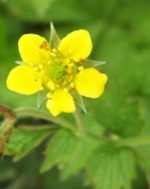 Also known as wood avens, colewort, and St. Benedict’s herb, this herbaceous perennial is a member of the rose family, Rosaceae, that also includes cherry, lady’s mantle, and Potentilla. It is native to shady and moist woodland edges and grasslands of Europe and the Middle East but was introduced into North America where it hybridizes with Geum canadense. The specific epithet, urbanum, refers to the fact that the plant tends follow human habitation and so is found growing in waste areas, parks, and gardens where people have changed the environment.
Also known as wood avens, colewort, and St. Benedict’s herb, this herbaceous perennial is a member of the rose family, Rosaceae, that also includes cherry, lady’s mantle, and Potentilla. It is native to shady and moist woodland edges and grasslands of Europe and the Middle East but was introduced into North America where it hybridizes with Geum canadense. The specific epithet, urbanum, refers to the fact that the plant tends follow human habitation and so is found growing in waste areas, parks, and gardens where people have changed the environment.
Description: Growing twelve to twenty eight inches tall, herb Bennet forms a basal rosette of pinnately compound leaves that have one to four pair of lobed or toothed leaflets and a terminal leaflet. Hairy stems carry flowers from late spring into summer with five bright yellow flowers that are ½” across and give way to achenes with red hooks that catch the fur of mammals and the clothing of humans, leading to wide seed dispersal. The clove scented roots produce whole plants from fragments.
Control: Plants should be hand dug before flowering and seed set but care must be taken to remove all of the root as fragments left behind in the soil will produce new plants. Chemical control is difficult because herb Bennet does not appear to be killed by selective herbicides. In severe cases a general non-selective, systemic glyphosate such as Round Up can be applied during active growth when the plant is flowering but several applications may be necessary.